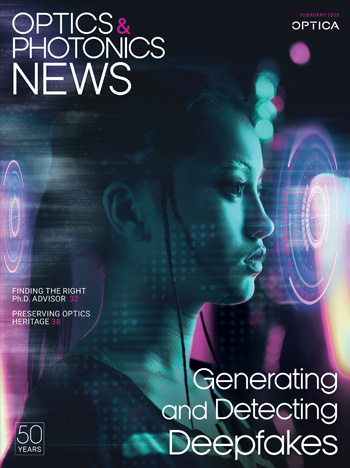
June 2011 Issue
Feature Articles
Cell Identification Computational 3-D Holographic Microscopy
Recent developments in 3-D computational optical imaging have ushered in a new era for biological research. Techniques in 3-D holographic microscopy integrated with numerical processing are enabling researchers to obtain rich, quantitative information about the structure of cells and microorganisms in noninvasive, real-time conditions.
by Inkyu Moon, Mehdi Daneshpanah, Arun Anand and Bahram JavidiRAPID Lithography: New Photoresists Achieve Nanoscale Resolution
Over the past decade, researchers have shattered the traditional view of the diffraction limit. Using new techniques, they have obtained resolution far smaller than the wavelength of light excitation or emission. Similar concepts are now being applied to photolithography, making it possible to create nanoscale features in a photoresist using visible or near-infrared light.
by John T. FourkasHeinrich Hertz and the Foundations of Electromagnetism
Heinrich Rudolf Hertz did not grasp the practical importance of his work during his lifetime, but his research into electromagnetic radiation laid the foundation for all wireless communications. The education and experience of this 19th century German scientist prepared him to make his monumental discoveries on propagating electromagnetic waves.
by Barry R. MastersDepartments and Columns
Optics and Photonics in Latin America
The launch of OSA’s Optics and Photonics Latin America website represents a milestone in OSA’s global program.
A Bright Future for Photonics21
The European technology platform has successfully unified the photonics community throughout the continent.
Two Presidents of the Mid-1960s
Two optical experts with an interest in military applications set their sights on the OSA presidency during the 1960s.
Communication Skills for Researchers: Don’t Settle for Status Quo
“Example is the school of mankind,” said the British statesman and philosopher Edmund Burke. However, for researchers who want to learn communication skills, example is perhaps the worst school. What are the alternatives?
Time-Reversed "Anti-Laser" Controls Light Absorption
What’s the exact opposite of a laser? The answer is not a riddle, but a real experiment in the controlled absorption of light.
Microscopic Techniques Aid Understanding of Protein Transport
Scientists can track the movement of protein through cells in three dimensions and study the responses of human immune cells to bacterial toxins.
Watching Molecular Machines Splice RNA
A recent paper in Science describes how this unusual combination of methods allows researchers to study the assembly of a so-called “spliceosome” in real time.
Controlling Inelastic Scattering in Graphene
Scientists directly observed quantum interference in graphene and figured out how to control the pathways by creating tiny ion-gel gates on doped graphene.

![Illustration of a synapse in the brain. [Getty Images]](https://opnmedia.blob.core.windows.net/$web/opn/media/images/articles/2025/0425/departments/202504-cover-web.jpg?ext=.jpg)
![Fiber draped around a hand, demonstrating its flexibility. [Photo by Z. Wang and L. Wei]](https://opnmedia.blob.core.windows.net/$web/opn/media/images/articles/2025/0325/departments/202503-cover-web.jpg?ext=.jpg)
